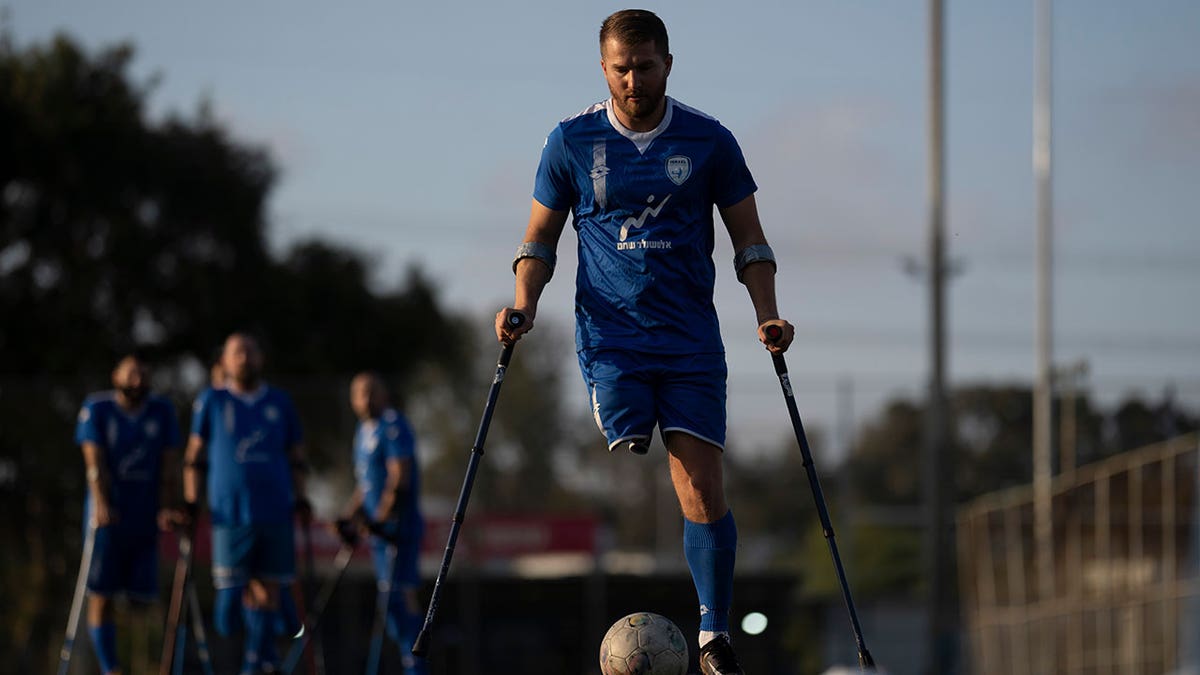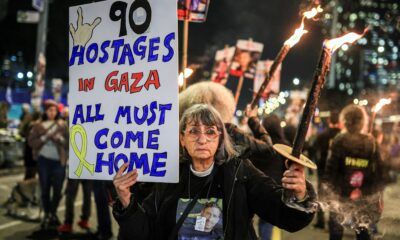INTERNACIONAL
Israel’s amputee soccer team offers healing to soldiers who lost limbs in Gaza

- Israel’s national amputee soccer team is heading to France for the 2024 European Amputee Football Championships in June.
- The team lineup includes two Israeli soldiers who were seriously wounded and lost limbs during the war in Gaza.
- Another team member was wounded in the Hamas militants’ attack on the Tribe of Nova music festival.
When Ben Binyamin was left for dead, his right leg blown off during the Hamas attack on the Tribe of Nova music festival, the Israeli professional soccer player thought he would never again play the game he loved.
«When I woke up,» the 29-year-old said, «I felt I was going to spend the rest of my life in a wheelchair.»
Then Binyamin learned about a chance to be «normal» again: Israel’s national amputee soccer team.
REPORTS OF ISRAEL’S RETALIATORY STRIKES AGAINST IRAN PROMPT REACTIONS FROM LAWMAKERS: ‘RIGHT TO DEFEND ITSELF’
The team, which includes two Israeli soldiers who lost limbs fighting in the war with Hamas, has offered all three a chance to heal from life-altering wounds suffered during the Oct. 7 attacks and Israel’s ensuing war in Gaza. It heads to France in June for the European Amputee Football Championships. Some 16 teams, mostly from Europe, will compete.

Israel Amputee Football Team player Ben Binyamin controls the ball during a practice session in Ramat Gan, on April 11, 2024. The team is heading to France for the 2024 European Amputee Football Championships in June. The team lineup includes two Israeli soldiers who were seriously wounded and lost limbs during the Hamas war in Gaza. (AP Photo/Leo Correa)
«It’s the best thing in my life,» said 1st Sgt. Omer Glikstal of the team’s twice-weekly practices at a stadium in the Tel Aviv suburb of Ramat Gan. The 20-year-old soldier from Haifa regularly played soccer until his life was turned upside-down when a rocket-propelled grenade shattered his left foot during a battle in Gaza in November.
«It’s a very different game than I used to play, but in the end, it’s the same,» he said.
Dozens of Israelis lost limbs during the Hamas attacks that killed some 1,200 people in southern Israel and the war that followed. Sheba Medical Center in Ramat Gan, home to a major rehabilitation center, says it alone has treated about 60 amputees.
ISRAEL STRIKES SITE IN IRAN IN RETALIATION FOR WEEKEND ASSAULT: SOURCE
Israel’s Defense Ministry says 1,573 soldiers have been wounded since Israel began its ground offensive in late October, in which troops have engaged in close combat with Hamas militants. The military did not have specific statistics on amputees but said some 320 soldiers were critically wounded.
The Israeli athletes and others who lost limbs have benefited from a world-class medical system that has decades of experience treating young people injured in wars and conflict.
In Gaza, unknown numbers of Palestinians have also lost limbs in a war that has claimed nearly 34,000 lives, according to Gaza health officials. Gaza’s health system has been overwhelmed by the war, and doctors and patients say they often need to choose between amputation or death. Before the war, Gaza also had a fledgling team of amputee soccer players wounded in previous conflicts with Israel.
Shaked Bitton, an Israeli army division commander, lost his right leg when he was shot by a Hamas sniper with a .50-caliber round — the type that can blast through concrete — near the Jabaliya refugee camp in late October. «I heard two shots. I fell down. I looked back,» the 21-year-old soldier said, «and I saw my leg.»
Bitton thought his life was over — he had never even met an amputee before — until he was visited in the hospital by others who had lost limbs and successfully resumed their lives.
Among them was Zach Shichrur, founder of Israel’s national amputee soccer team. Severely injured when a bus ran over his foot at age 8, he knew what these men were going through, and he offered them hope.
«There is nothing greater than to go out and compete at the international level when you have the Israeli flag on your chest. Most of us, if not all, could not have even imagined something like this,» said Shichrur, 36, an attorney and the team’s captain.
Since its founding five years ago, the Israeli team has met with growing success, placing third in the Nations League in Belgium in October. That qualified it to compete in the European championship in June.
Amputee soccer teams have six fielder players who are missing lower limbs; they play on crutches and without prosthetics. Each team has a goalkeeper with a missing upper extremity. The pitch is smaller than standard.
At team practices, the Israeli players are undeterred by the absence of an arm or a leg — whether from an accident, a war injury or a birth defect.
«We all have something in common. We’ve been through a lot of hard and difficult times. It unites us,» said Aviran Ohana, a cybersecurity expert whose right leg is shorter than his left due to a birth defect, and who has played with the team for two years.
On a recent April evening, the team started its warm-up with sprints around the pitch, the men speeding forward propelled by one leg, steadied by their crutches.
CLICK HERE TO GET THE FOX NEWS APP
A game against able-bodied teenagers followed. Binyamin, dripping with sweat, kicked the ball with his left leg as the coach shouted from the sidelines: «Forward! Forward!» Every goal was celebrated.
Sir Ludwig Guttmann, a Jewish neurologist who fled Nazi Germany in 1939 and settled in Britain, is credited with pioneering competitive sports as a form of rehabilitation. Guttmann, who organized the first competition for wheelchair athletes on the opening day of the 1948 London Olympic Games, is considered the father of the Paralympic Games, and his legacy has enhanced the lives of thousands of handicapped athletes.
In Israel today, the amputee soccer team offers the players the excitement of competition — and the healing powers of sport, said Michal Nechama, the team’s physical therapist.
«They need it for their soul,» she said. «It gives them joy, pride. That extra thing that you can’t give in a hospital.»
INTERNACIONAL
Tragedia aérea en Washington: quién era el argentino que murió junto a su hijo de 13 años

Luciano Aparicio, un contador formado en la UBA y miembro de una empresa energética con sede en Estados Unidos, era el argentino que viajaba en el avión que fue chocado por un helicóptero en Washington. Murió junto a su hijo Franco, de 13 años y nacido en Chile, a quien había acompañado a un competencia de patinaje. Su esposa los esperaba en el aeropuerto cuando ocurrió la tragedia.
Aparicio se había recibido de contador en la Universidad de Buenos Aires y luego continuó sus estudios en Estados Unidos. Actualmente, era vicepresidente de una empresa de energía eléctrica con sede en Arlington, Virginia, muy cerca del aeropuerto donde ocurrió la tragedia. Había vivido varios años en Chile.
Su hijo practicaba patinaje artístico y, más allá de concurrir al colegio estadounidense, era alumno de la Escuela Argentina, una institución en las afueras de Washington donde asisten hijos de argentinos los sábados por la mañana para continuar cursando la currícula del país y estar en contacto con su comunidad.
La madre y esposa, también argentina, estaba esperando en el aeropuerto Ronald Reagan que aterrizara el vuelo donde llegaba sus familiares cuando poco antes de las 9 de la noche del miércoles, hora de Washington, se produjo el accidente y todo se transformó en desesperación. Hasta allí habían llegado las autoridades de American Airlines que estaban en contacto con ellos.
Poco a poco fueron dando información a los familiares que estaban en el lugar, que temían lo peor. Por la mañana les habían dicho que ya no había esperanzas, pero la lista oficial de fallecidos se difundió más tarde.
Luciano y su hijo Franco estaban entre las 64 personas que viajaban en el avión de la empresa American Airlines que chocó con el helicóptero militar cuando se acercaba al eropuerto Ronald Reagan.
En relación con las posibles causas del fatal choque, un informe preliminar de la Administración Federal de Aviación (FAA) apunta que la dotación de personal dedicado al control aéreo «no era normal para la hora del día y el volumen de tráfico».
Medios estadounidenses que tuvieron acceso a ese informe dicen que el escaso número de trabajadores hizo que una persona tuviera que hacerse cargo de dos tareas a la vez: el control aéreo tanto del tráfico de aviones y de los helicópteros que sobrevuelan la capital de los Estados Unidos.
Sin embargo, el presidente Donald Trump sumó otro punto de vista al poner el foco en que el helicóptero volaba demasia alto.
«El helicóptero Blackhawk volaba demasiado alto. Estaba muy por encima del límite de 200 pies. Eso no es realmente demasiado complicado de entender, ¿verdad?», sostuvo Trump en su red social Truth.
-
POLITICA3 días ago
Mariano Cúneo Libarona cerró otras 155 sedes del Registro Automotor: “Motosierra 2.0”
-
POLITICA2 días ago
Expulsaron a Ramiro Marra de La Libertad Avanza
-
ECONOMIA2 días ago
Javier Milei celebró en redes un dato de recuperación económica
-
POLITICA14 horas ago
Para los principales analistas la inflación de enero no superó el 2,5%
-
POLITICA14 horas ago
Inseguridad: no más ideología ni chicanas políticas
-
INTERNACIONAL3 días ago
DeepSeek y la censura china: las preguntas que la app no «sabe» responder









































